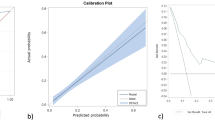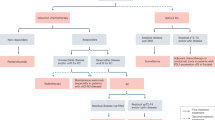Abstract
Regional lymph node dissection (LND) at the time of radical cystectomy is an essential component of the surgical management of invasive bladder cancer and might provide diagnostic and therapeutic benefits for both node-negative and node-positive patients. The benefits obtained in pathologically node-negative patients might result from more complete resection of undetected micrometastases or from a more meticulous surgical technique. Advanced nodal disease also seems to be amenable to thorough surgical resection in a subpopulation of patients with bladder cancer. Despite the growing body of evidence to support the role of a more extended LND, no guidelines regarding the optimal boundaries of LND have been established. An increased number of resected nodes and wider LND boundaries have been associated with improved local disease control and prolonged survival. Additionally, mapping series indicate that the common iliac and presacral nodal regions are more frequently involved with tumor metastases than previously recognized. Efforts to limit any unnecessary dissection in patients at low risk for metastases—a tailored approach—has been proposed, but remains unproven. From the available evidence, the most reliable diagnostic and therapeutic approach to LND includes the routine extended LND in all patients undergoing cystectomy with curative intent.
Key Points
-
A high number of lymph nodes identified in the surgical specimen is associated with a significant improvement in local disease recurrence and overall survival
-
Expansion of the lymph-node dissection to include common iliac, presacral and periaortic nodes is not associated with an increase in perioperative morbidity or mortality
-
Both pathologically node-negative and node-positive patients gain a significant survival advantage from a more extensive lymph-node dissection
-
The survival advantage associated with lymph-node dissection in node-negative patients might be associated with excision of undiagnosed micrometastases
-
Lymph-node density might be a more efficacious method for the risk stratification of node-positive patients than the current tumor-node-metastasis staging system
This is a preview of subscription content, access via your institution
Access options
Subscribe to this journal
Receive 12 print issues and online access
$209.00 per year
only $17.42 per issue
Buy this article
- Purchase on Springer Link
- Instant access to full article PDF
Prices may be subject to local taxes which are calculated during checkout
Similar content being viewed by others
References
Stein JP et al. (2006) Lymphadenectomy for invasive bladder cancer: I. Historical perspective and contemporary rationale. BJU Int 97: 227–231
Stein JP et al. (2006) Lymphadenectomy for invasive bladder cancer. II. Technical aspect and prognostic factors. BJU Int 97: 232–237
Kerr WS and Colby FH (1950) Pelvic lymph node dissection and total cystectomy in the treatment of carcinoma of the bladder. J Urol 63: 842–851
Leadbetter WF and Cooper JF (1950) Regional gland dissection for carcinoma of the bladder: a technique for one-stage cystectomy, gland dissection and bilateral uretero-enterostomy. J Urol 63: 242–260
Stein JP et al. (2001) Radical cystectomy in the treatment of invasive bladder cancer: long-term results in 1,054 patients. J Clin Oncol 19: 666–675
Leissner J et al. (2004) Extended radical lymphadenectomy in patients with urothelial bladder cancer: results of a prospective multicenter study. J Urol 171: 139–144
Whitmore WF and Marshall VF (1962) Radical total cystectomy for cancer of the bladder: 230 consecutive cases five years later. J Urol 87: 853–868
Skinner DG (1982) Management of invasive bladder cancer: a meticulous pelvic node dissection can make a difference. J Urol 128: 34–36
Wishnow KI et al. (1987) Incidence, extent and location of unsuspected pelvic lymph node metastasis in patients undergoing radical cystectomy for bladder cancer. J Urol 137: 408–410
Konety BR et al. (2003) Extent of pelvic lymphadenectomy and its impact on outcome inpatients diagnosed with bladder cancer: Analysis of data from the surveillance, epidemiology and end results program data base. J Urol 169: 946–950
Poulsen AL et al. (1998) Extending the limits of pelvic node dissection improves survival for patients with bladder cancer confined to the bladder wall. J Urol 160: 2015–2019
Leissner J et al. (2000) Lymphadenectomy in patients with transitional cell carcinoma of the urinary bladder; significance for staging and prognosis. BJU Int 85: 817–823
Brossner C et al. (2004) Does extended lymphadenectomy increase the morbidity of radical cystectomy? BJU Int 93: 64–66
Fleischmann A et al. (2005) Extracapsular extension of pelvic lymph node metastases from urothelial carcinoma of the bladder is an independent prognostic factor. J Clin Oncol 23: 2358–2365
Herr HW et al. (2002) Impact of the number of lymph nodes retrieved on outcome in patients with muscle invasive bladder caner. J Urol 167: 1295–1299
Vieweg J et al. (1999) The impact of primary stage on survival in patients with lymph node positive bladder cancer. J Urol 161: 72–76
Mills RD et al. (2001) Pelvic lymph node metastases from bladder cancer: outcome in 83 patients. J Urol 166: 19–23
Honma I et al. (2004) Local recurrence after radical cystectomy for invasive bladder cancer: an analysis of predictive factors. Urology 64: 744–748
Vazina A et al. (2004) Stage specific lymph node metastasis mapping in radical cystectomy specimens. J Urol 171: 1830–1834
Bochner BH et al. (2004) Prospectively packaged lymph node dissections with radical cystectomy: evaluation of node count variability and node mapping. J Urol 172: 1286–1290
Vieweg J et al. (1994) The role of pelvic lymphadenectomy and radical cystectomy for lymph node positive bladder cancer. The Memorial Sloan–Kettering Cancer Center experience. Cancer 73: 3020–3028
Abol-Enein H et al. (2004) Lymph node involvement in patients with bladder cancer treated with radical cystectomy: a patho-anatomical study—a single center experience. J Urol 172: 1818–1821
Stein JP et al. (2003) Risk factors for patients with pelvic lymph node metastases following radical cystectomy with en bloc pelvic lymphadenectomy: the concept of lymph node density. J Urol 170: 35–41
Vieweg J et al. (1999) Pelvic lymph node dissection can be curative in patients with node positive bladder cancer. J Urol 161: 449–454
Ghoneim MA et al. (1997) Radical cystectomy for carcinoma of the bladder: critical evaluation of the results in 1,026 cases. J Urol 158: 393–399
Lerner SP et al. (1993) The rationale for en bloc pelvic lymph node dissection for bladder cancer patients with nodal metastases: long-term results. J Urol 149: 758–764
Kassouf W et al. (2006) Evaluation of the relevance of lymph node density in a contemporary series of patients undergoing radical cystectomy. J Urol 176: 53–57
Ficarra V et al. (2005) Correlation between clinical and pathological staging in a series of radical cystectomies for bladder cancer. BJU Int 95: 786–790
Drieskens O et al. (2005) FDG-PET for preoperative staging of bladder cancer. Eur J Nucl Mol Imag 32: 1412–1417
Picchio M et al. (2006) Value of 11C-choline PET and contrast-enhanced CT for staging of bladder cancer: correlation with histopathologic findings. J Nucl Med 47: 938–944
Herr HW (2003) Superiority of ratio based lymph node staging for bladder cancer. J Urol 169: 943–945
Herr HW and Donat SM (2001) Outcomes of patients with grossly positive bladder cancer after pelvic lymph node dissection and cystectomy. J Urol 165: 62–64
Retz J et al. (2004) Detection of occult tumor cells in lymph nodes from bladder cancer patients by MUC7 nested RT-PCR. Eur Urol 45: 314–319
Copp HL et al. (2006) Prospective evaluation of the prognostic relevance of molecular staging for urothelial carcinoma. Cancer 107: 60–66
Herr HW et al. (2004) Surgical factors influence bladder cancer outcomes: a cooperative group report. J Clin Oncol 22: 2781–2789
Bochner BH et al. (2001) Impact of separate versus en bloc pelvic lymph node dissection on the number of nodes retrieved in cystectomy specimens. J Urol 166: 2295–2296
Stein JP et al.: Radical cystectomy with an extended lymphadenectomy—evaluating separate package versus en bloc submission in node-positive bladder cancer. J Urol, in press
Weingärtner K et al. (1996) Anatomical basis for pelvic lymphadenectomy in prostate cancer: results of an autopsy study and implications for the clinic. J Urol 156: 1969–1971
Liedberg F et al. (2006) Intraoperative sentinel node detection improves nodal staging in invasive bladder cancer. J Urol 175: 84–89
Jewett HJ and Strong GH (1946) Infiltrating carcinoma of the bladder: relation of depth of penetration of the bladder wall to incidence of local extension and metastases. J Urol 55: 366–372
Rouviere H (1938) Anatomy of the Human Lymphatic System. Ann Arbor: Edwards Brothers
Battezzati M and Donini I (1972) The Lymphatic System. New York: John Wiley & Sons
Wada N et al. (2004) Evaluation of intraoperative frozen section diagnosis of sentinel lymph nodes in breast cancer. Jpn J Clin Oncol 34: 113–117
Lerner SP (2004) The evolving role of pelvic lymphadenectomy in the treatment of bladder cancer. Urol Oncol 22: 212
Wiesner C et al. (2005) Lymph node metastases in non-muscle-invasive bladder cancer are correlated with the number of transurethral resections and tumour upstaging at radical cystectomy. BJU Int 95: 301–305
Author information
Authors and Affiliations
Corresponding author
Ethics declarations
Competing interests
The authors declare no competing financial interests.
Rights and permissions
About this article
Cite this article
Sanderson, K., Skinner, D. & Stein, J. The prognostic and staging value of lymph node dissection in the treatment of invasive bladder cancer. Nat Rev Urol 3, 485–494 (2006). https://doi.org/10.1038/ncpuro0582
Received:
Accepted:
Issue Date:
DOI: https://doi.org/10.1038/ncpuro0582
This article is cited by
-
PET/CT versus conventional CT for detection of lymph node metastases in patients with locally advanced bladder cancer
BMC Urology (2015)
-
Lymphotropic nanoparticle enhanced MRI for the staging of genitourinary tumors
Nature Reviews Urology (2010)



